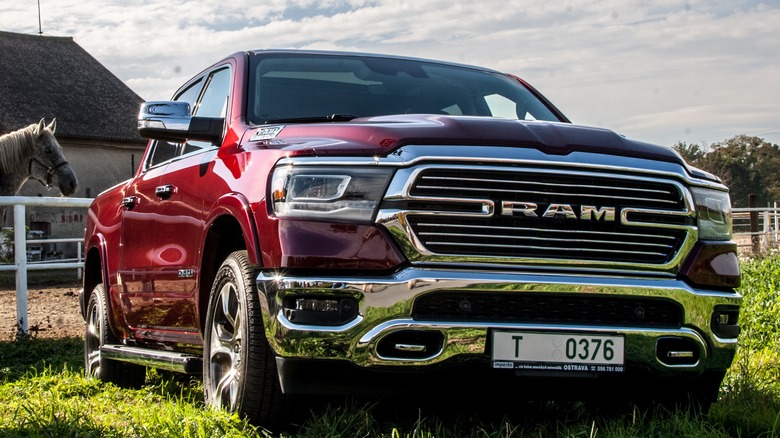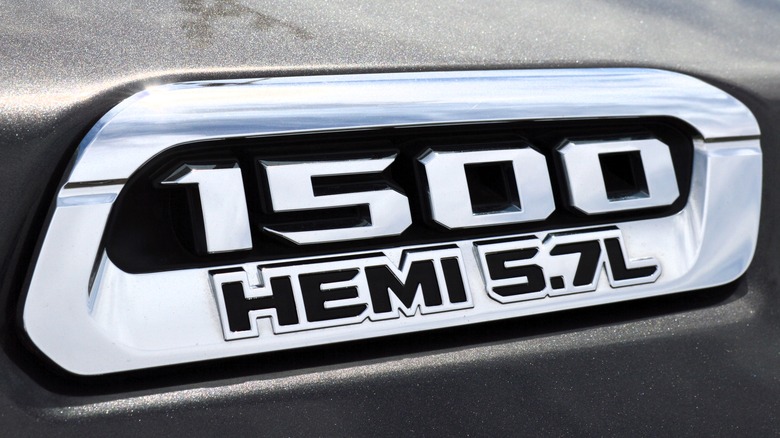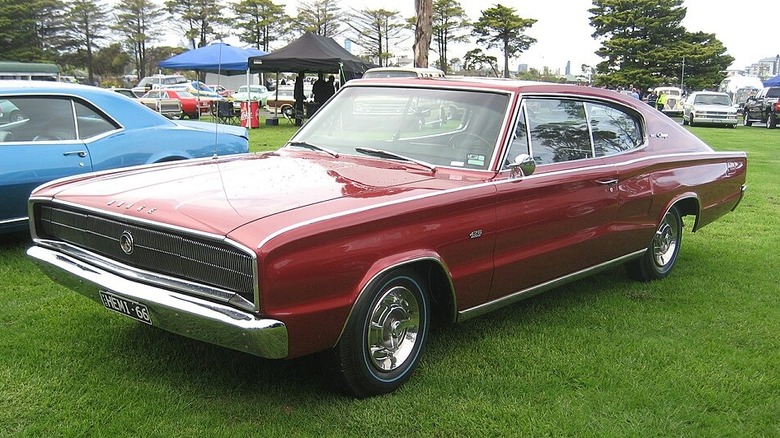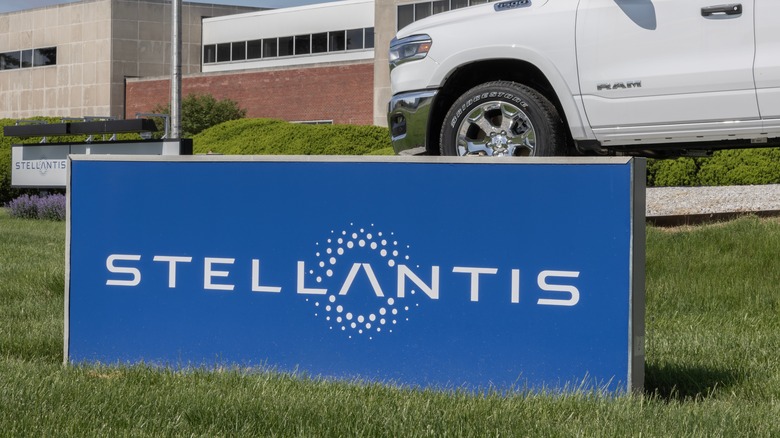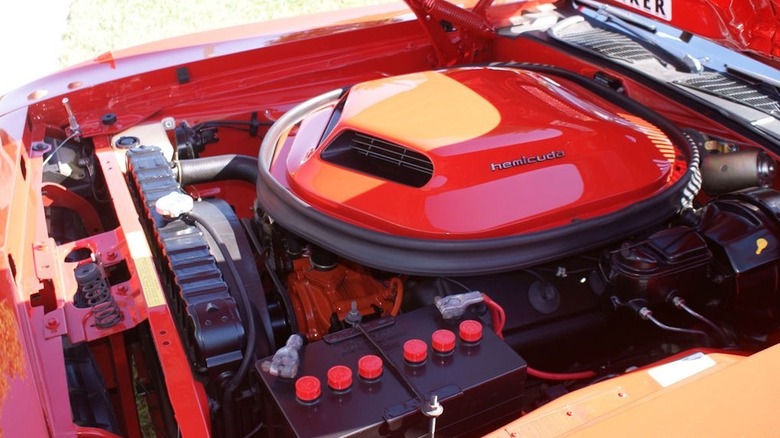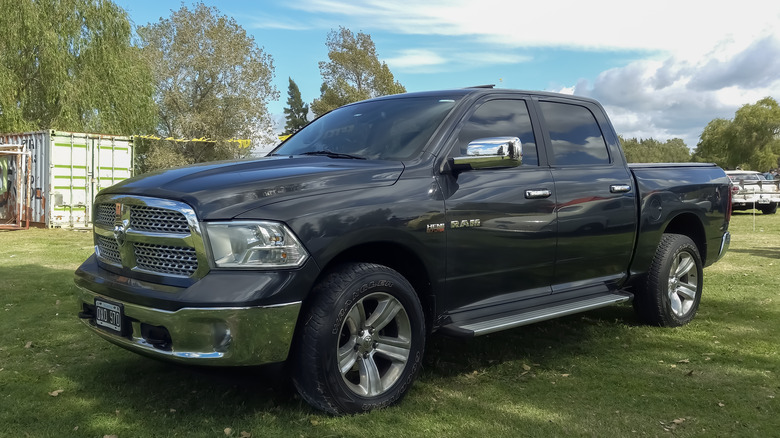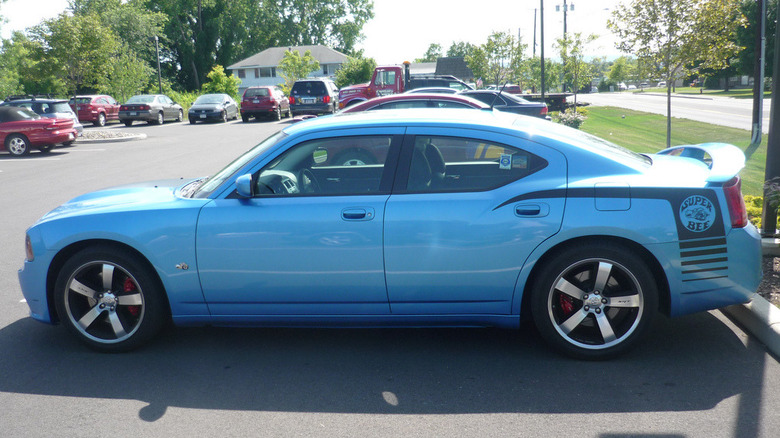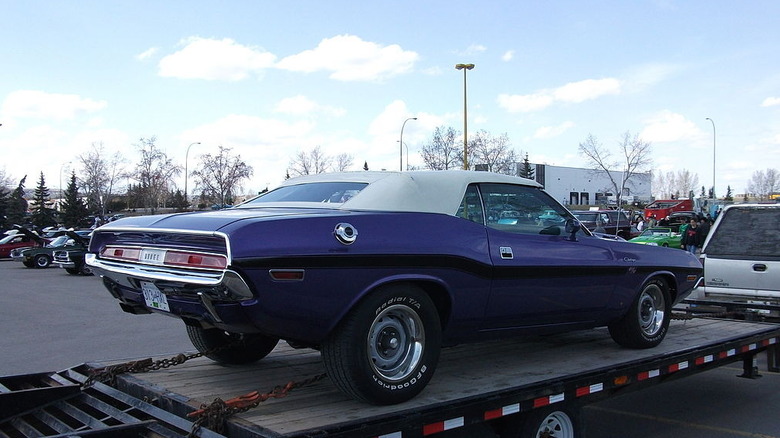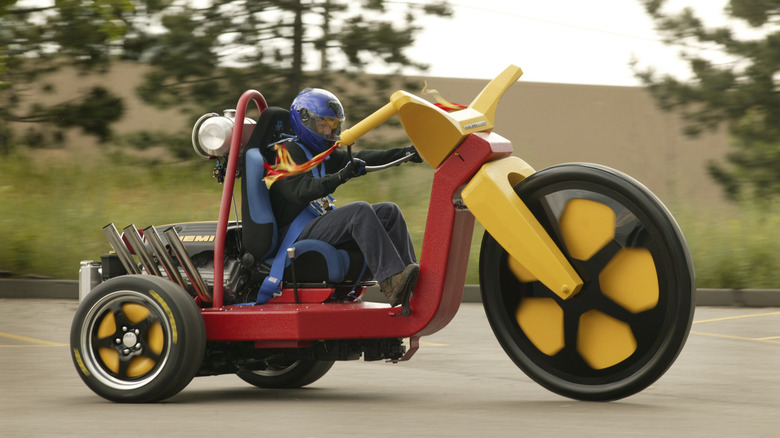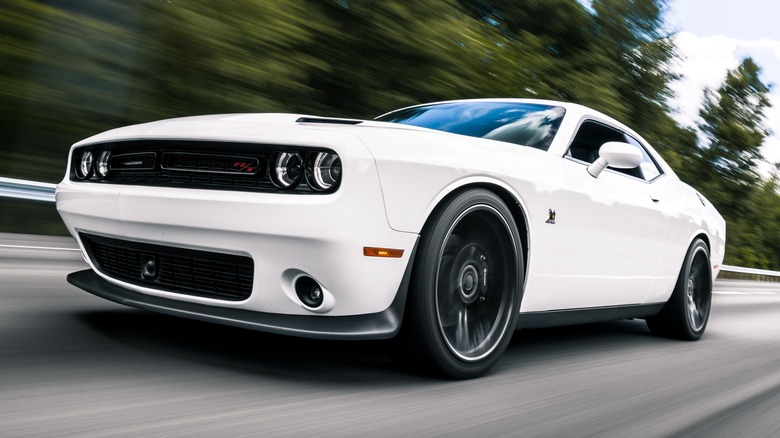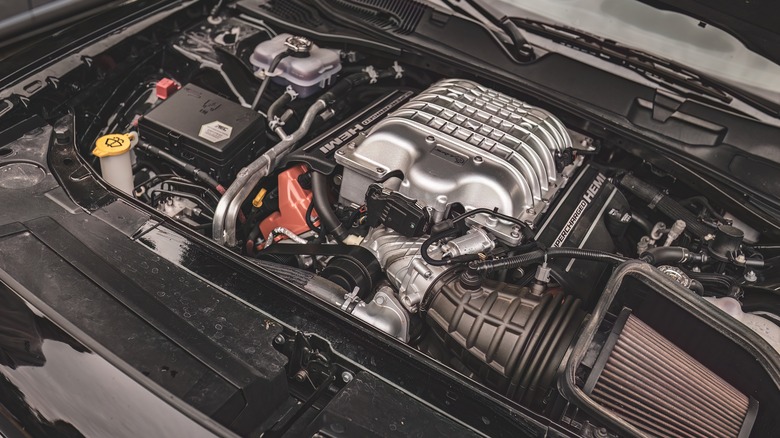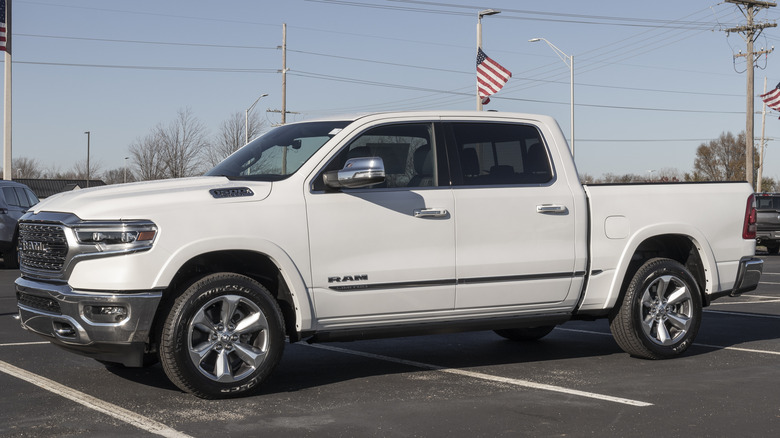12 Interesting Facts Every Car Enthusiast Should Know About HEMI Engines
Any '90s kid who had cable TV will distinctly remember the '00s-era commercials that posed the question, "That thing got a HEMI?" While the tongue-in-cheek commercial was used to point out that not only did Dodge Chargers have HEMI engines, but that Dodge trucks could also have them, the commercial didn't tell consumers a whole lot about HEMIs. We learned they were cool, sure, but beyond that, the HEMI decal might have seemed more like a marketing tool than a worthwhile feature.
HEMI engines might be best known for rumbling under the hood of iconic muscle cars, but there's a whole lot more to know about the unique engines. Did you know that years ago, HEMIs were also used in fighter jets? Chrysler (known as Stellantis since a merger in 2021; we'll use the two names interchangeably here) has come a long way since its WWII prototypes, but there's also some not-so-great news about the future of the HEMI given U.S. emissions regulations.
The storied HEMI engine — stylized as such by Chrysler but often modified to Hemi by publications — has a long history, and there's a lot to know about its origins and its future in the automotive industry. Here are 12 interesting facts every car enthusiast needs to know about HEMI engines, including what to expect as the era just might be coming to an end.
HEMI doesn't refer to a specific engine
While Chrysler popularized the Hemi engine, they didn't recreate the wheel when designing it. Hemi just means hemispherical combustion chambers, with Hemi being short for hemispherical. In a Hemi engine, there are two "hemispheres," so the intake and exhaust valves are opposite each other.
A Hemi engine can come in various sizes, and even the same generation Chrysler HEMI engine (apparently HEMI is the trademarked designation) has size variations. Starting in 2003, the third-generation HEMI debuted. Though there have been updates in the years since, things haven't changed all that much.
Chrysler manufactured various sizes of engines ranging from 5.7 liters (namely in Dodge Rams) to 6.4 liters (in Dodge's Challenger and Charger), but not many things have changed throughout the third generation. For example, the horsepower has increased somewhat, and third-generation HEMI engines had slightly improved fuel economy (15 MPG on the 2009 Dodge Ram 1500 versus 14 MPG on the 2008 Dodge Ram 1500).
However, there is one caveat in terms of what engines are labeled HEMIs today. As of the third generation rollout, a HEMI isn't truly hemispherical anymore. Instead, Chrysler moved to more of a flattened-sphere shape for better combustion efficiency. The modern HEMIs may no longer be true HEMIs, but that doesn't mean performance has suffered.
The first HEMI debuted in the early 1900s -- on a boat
Ready for some more, perhaps even surprising news? Chrysler might have popularized the HEMI, but the brand didn't invent it. The earliest HEMI engine debuted in the early 1900s and was actually a boat engine. Other early HEMI engines were used in automobiles, including race cars, and Chrysler wasn't the only brand in the running.
The early generation of Chrysler HEMI engines developed between 1951 and 1958 were labeled FirePower instead of the now-ubiquitous HEMI. Chrysler's subsidiaries also had their own HEMI monikers; HEMIs at that time were known as FirePower (Chrysler and Imperial), FireDome (Dodge), or Red Ram (Plymouth) engines, depending on the make of the vehicle.
Second-generation Chrysler HEMI engines lasted from 1964 to 1971 and were bigger (and perhaps better) than the prior generation. The second-gen HEMI engine rollout also included a street version of the HEMI. Notable cars with second-gen street HEMI engines included 1966 to 1971 model years of Dodge Charger, Plymouth GTX, Plymouth Barracuda, Dodge Challenger, and others.
Also known as an Elephant engine, the second-generation HEMI engine was a 426 cubic inch V8 with 60.9 horsepower per liter and 490 lb-ft of torque.
[Featured image by Sicnag via Wikimedia Commons | Cropped | CC BY 2.0]
Chrysler manufactured HEMIs for WWII fighter aircraft
One interesting detail in Chrysler's HEMI history is the fact that the vehicle manufacturer once created engines for World War II aircraft. History buffs already know about Chrysler's involvement in WWII, but the average driver might not. To recap, Chrysler manufactured thousands of tanks, anti-aircraft guns, trucks, and other equipment for the war.
Later, Chrysler also manufactured an engine for the P-47 Thunderbolt fighter aircraft. The XIV-2220 (later renamed the XI-2220) engine had over 2,500 horsepower (Chrysler even planned for higher horsepower) and measured over ten feet long. By 1944, Chrysler had its engines ready but had to modify P-47 Thunderbolt aircraft to accommodate the massive HEMIs.
However, by the time Chrysler was ready for flight tests in July 1945, it was too late to produce the engines for the war; the war ultimately concluded in September 1945. The XIV-2220 engine was never put into production, although it wasn't all for naught in terms of design and innovation.
The fighter aircraft engine was technically Chrysler's first-ever HEMI, and other versions soon followed — but this time, they were built for cars.
[Featured image by Tony Hisgett via Wikimedia Commons | Cropped | CC BY 2.0]
Stellantis is discontinuing HEMIs
As epic of a run as Chrysler has had with HEMI engines, nothing can last forever. In early 2023, it was announced that automobile corporation Stellantis is moving away from HEMIs due to emissions issues and industry evolution.
Lawton Chrysler Jeep Dodge out of Oklahoma announced in April 2023 that the dealership would no longer have HEMI engine-equipped Jeep or Dodge (Ram) vehicles available for purchase by the end of the year. Some dealerships suggested that the 2023 model year would be the end of the HEMI engine as it currently exists.
News reports declared that Stellantis was nixing V8 HEMI engines to reduce emissions in its North American vehicles. Per a Reuters report, Stellantis will not manufacture 2025 light-duty Rams with HEMI V8s. Instead, 2025 Rams will have V6 engines with the option for battery-electric engines.
There is a clear motivation in Stellantis moving away from the HEMI engine. According to Reuters, Stellantis has been paying fines for emissions failures in the U.S., and the charges are only piling up as emissions regulations change.
A replacement HEMI is coming
While Dodge and other Stellantis subsidiaries are discontinuing HEMI engines, a quasi-replacement is coming. A new engine will reportedly be more efficient than the HEMI and serve as a non-electric replacement.
Over time, the power-packed HEMI engine has been toned down to meet emissions standards and wrangle with fuel economy. After paying hundreds of millions of dollars in fines for its HEMI engines in various years (between 2016 and 2019), Stellantis seemed ready to make a change. Thus, the inspiration for a new "HEMI" was born.
A new HEMI-esque engine — a turbocharged three-liter model — meets regulations without sacrificing the power that HEMI engine enthusiasts enjoy. With 420 horsepower and 460 lb-ft of torque, the Hurricane engine is nothing to scoff at. A higher-output version increases the stats more; it offers 540 horsepower and 469 lb-ft of torque.
That means the new non-HEMI engine will actually outperform the 5.7-liter HEMI engine, which has 395 horsepower and 410 lb-ft of torque. It's also not new; Stellantis began manufacturing the Hurricane GME-T6 engine in 2021 and offered it in 2022 Jeep Grand Wagoneers. Starting in 2025, Stellantis will offer both Hurricane options for Dodge Chargers and Ram 1500s.
[Featured image by Valder137 via Wikimedia Commons | Cropped | CC BY 2.0]
HEMIs are known for a telltale tick
HEMI engines are widely beloved, but they're not perfect. In addition to emissions issues, HEMI engines also have a common issue that many consumers find annoying and even dangerous. It might sound small, but in some of the worst years for the Dodge 5.7-liter HEMI has had a telltale "tick" sound that has driven consumers up the wall.
Third-generation HEMI engines, in particular, are reported to have an audible ticking sound that seems to hint at engine dysfunction. The 2012 Dodge Ram 1500 was especially well-known for the engine ticking problem, which consumers have reported as a knocking or tapping sound.
A lawsuit from consumers suggests the HEMI tick is dangerous and costly to fix. One complaint from drivers is that the tick can actually cause a loss of power, which they consider a hazard, especially at highway speeds. Consumers also allege that the tick causes a loss of value, though it also costs money to repair; one consumer said she was quoted $4,500 to fix the knocking noise.
While various publications suggest that Chrysler has addressed the ticking issue — with one news source reporting that the company only replied to state that it doesn't comment on pending litigation — there does not appear to be a written statement online.
Chrysler was the first to market the term HEMI
Although Chrysler wasn't the first to manufacture a HEMI engine, the company was the first to market the term. In an effort to promote the high-powered engine, Chrysler released various commercials starring the HEMI engine.
The phrase, "That thing got a HEMI?" became a pop culture reference thanks to Chrysler's second-ever HEMI commercial. In 2004, Chrysler released the commercial, in which two men in an older-model Plymouth Duster (assumed to be a 1966 to 1971, since those years had a HEMI engine) pull up alongside a Dodge Ram Heavy Duty pulling a Dodge Charger on a flatbed trailer.
After the passenger asks, "That thing got a HEMI?" and the truck driver says, "Yeah," the other driver revs his engine, but the Dodge Ram pulls away when the light turns green. At the next light, the driver of the Ram asks, "Did you mean the Charger? 'Cause that's got a HEMI, too." Chastised, the passenger and driver both nod awkwardly.
Such HEMI commercials were a staple on cable TV back then, and they just might have inspired other vehicle manufacturers to jump on the trend. They did, at least, popularize the Dodge Ram HEMI.
[Featured image by Jason Lawrence via Wikimedia Commons | Cropped | CC BY 2.0]
Chrysler doesn't make the only HEMIs
While Chrysler was known for manufacturing the most well-known HEMI engine (though not the first), the car manufacturer isn't the only automaker to tinker with HEMI designs. While other brands never popularized their HEMI engines as much as Chrysler did, companies like Toyota did release hemispherical engine designs.
Toyota went so far as to enlist the help of Yamaha to create a V8 "HEMI." Unfortunately for Toyota, its mass-produced Hemi engine was not as powerful as Chrysler's, with 114 horsepower and 145 lb-ft of torque.
For reference, the Chrysler 5.7 HEMI produces 345 horsepower, which suggests there's no way Toyota could have competed with Chrysler's entry. Toyota did create a second generation of its V8 HEMI engine, but none of its Hemi class vehicles ever made it to the U.S.
As far as usage of the Chrysler HEMI engine, many cars also have Chrysler 6.4-liter 392 HEMIs, not just Dodge Rams. Many Jeeps — Jeep is also owned by Stellantis — have 392 HEMI engines, as do various Dodge vehicles, even the Durango.
According to Motor Trend, other HEMI engines do exist, but none that have been mass-produced. Brands such as Chevrolet, Ford, and Oldsmobile Hemi engines are out there, but good luck finding one in a new car these days.
[Featured image by dave_7 via Wikimedia Commons | Cropped | CC BY 2.0]
DaimlerChrysler built out-there HEMIs
Chrysler has done some crazy things with its HEMI promotion, including building concept vehicles featuring the HEMI. Back when Stellantis was known as DaimlerChrysler, the company held a contest where participants could design a HEMI-engine-centered vehicle, and then the automaker brought the winners' vehicles to life.
Hundreds of people submitted ideas (and essays), but only five finalists got to see their creations made life-sized. The grand prize winner of the 2005 contest was the HEMI Trike, which used a 5.7-liter HEMI V8 engine. Other entries included a snowblower, a merry-go-round, an ice resurfacer, and even a giant shredder. The winner received an actual HEMI-powered Chrysler, Jeep, or Dodge vehicle.
At that time, DaimlerChrysler's news release summed up the history of the HEMI engine by noting that high manufacturing costs caused a pause in production in 1959. In 1964, Chrysler dove into NASCAR competitions, which was the impetus for producing the second-generation HEMI engine.
It seemed that the competition was meant to spur further interest in the HEMI, especially following the uptick in attention after the commercials in the early 2000s.
Most HEMIs can handle midgrade gasoline
Chrysler HEMI engine-powered vehicles have a reputation for being high-performance and, sometimes, high-maintenance. From the costly ticking issue to routine maintenance to low gas mileage, driving a HEMI isn't for everyone. However, the engines might not be as finicky as consumers expect.
While drivers might prefer premium, many HEMIs can handle lower-octane gasoline, according to dealerships for Chrysler vehicles. For example, the Dodge Charger R/T with a V8 HEMI engine requires 89-octane gas (midgrade), per Chrysler dealerships, though consumers should always refer to their user manuals for specifics.
Anecdotally, Car and Driver's tests with a Dodge Charger R/T suggest that lower-octane fuel is fine for the 5.7-liter HEMI engine, especially as there's no notification to drivers on the fuel door. The manual, the publication notes, says that 87-octane fuel is "satisfactory."
Car and Driver did suggest that there's a slight 0.3 MPG gas mileage improvement while using 93-octane fuel. However, speed tests only differed when it came to the 0 to 100 MPH test (93 octane made a 0.2-second difference) and quarter-mile test (a 0.1-second improvement at 106 MPH).
1500 is the highest HEMI horsepower to date
If there's one thing a Chrysler HEMI engine is known for, it's power. Even from the first commercials featuring a Dodge Ram HEMI, Chrysler-turned-Stellantis has maintained that power is the focus. It's not surprising, then, that high horsepower is a sought-after metric.
Chrysler has manufactured many high-horsepower HEMI engines, but its highest — in the Dodge Direct Connection 1500 HEMI — ranks at 1,500 horsepower. The Direct Connection is not the kind of engine you can get as an option at the dealership, though. You also won't find its high-octane gas at any local gas stations.
The Direct Connection HEMI engine requires E85 gas and can't take anything else, which suggests just how specialized the record-breaking engine is. As of March 2024, the engine wasn't yet available for purchase, but that might be a good thing since you'll need time to save up; the Direct Connection engine costs almost $60,000. Fortunately for most drivers, the standard HEMI engine's 345 horsepower is plenty.
HEMIs may not last because of emissions
While Stellantis has been working on a turbocharged engine to replace the HEMI engines of today, the new models technically won't be HEMIs any longer. Unfortunately, it doesn't appear that the HEMI engine can make a comeback, at least not in its current iteration.
All HEMI engines emit high levels of oxides of nitrogen that may not meet emissions standards. It's not surprising that Stellantis was dinged with fines for various years of Rams not meeting emissions requirements, and although the company is worth plenty of money, hundreds of millions in fines per model-year quickly add up.
That's not to say the HEMI engine will disappear entirely. It seems that the Chrysler HEMI engine will still be used in some 2024 model year vehicles, based on various sources' reporting (including dealership advertisements). A 30-year gap between the second and third-generation HEMIs left plenty of room for improvement. Plus, after so much time, effort, resources, and reputation poured into the HEMI engine, Stellantis may not be willing to walk away without a fight.
